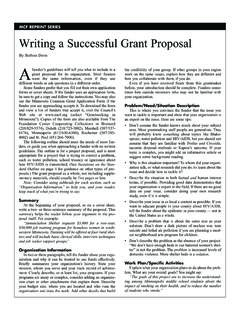Transcription of Essentials of Autoethnography
1 VSeries Foreword Clara E. Hill and Sarah Knox vii1. Conceptual foundations of Autoethnography 3 What Is Autoethnography ? 4 History 6 Rationale 10 Situating Autoethnography in the Qualitative Tradition 11 Pioneers and Turning Points 13 Philosophical and Epistemological Background 14 Key Distinguishing Features of Autoethnography 162. Doing Autoethnography : Design and Data Collection 19 Openings 19 Practices 20 Engaging Participant Observation 21 Examining Sense Data (Perceptions) 22 Exploring Emotions 22 Formulating Research Questions 23 Conducting Exploratory Research 24 Searching for Stories, Conversations, and Artifacts 25 Mining Memories 27 Engaging in Systematic Reflexive Introspection 28 ContentsCOPYRIGHT AMERICAN PSYCHOLOGICAL ASSOCIATIONvi Contents3.
2 Writing Autoethnography 31 Writing as a Method of Inquiry 31 Assumptions 34 Getting Started 37 Building Momentum 414. Process and Craft 51 Considerations 54 Narrative Conventions of Autoethnography 555. Variations on the Method 67 Layered Accounts 68 Critical Autoethnography 69 Performance Autoethnography 69 Poetic Inquiry 70 Autoethnography as Social Fiction 71 Collaborative Autoethnography 716. Methodological Integrity, Summary, and Conclusions 73 Evaluating Autoethnography 74 Ethics 76 Summary and Conclusions 77 Appendix.
3 Exemplar Studies 79 References 81 Index 89 About the Author 97 About the Series Editors 99 COPYRIGHT AMERICAN PSYCHOLOGICAL ASSOCIATIONviiQualitative approaches have become accepted and indeed embraced as empirical methods within the social sciences, as scholars have realized that many of the phenomena in which we are interested are complex and require deep inner reflection and equally penetrating examination. Quantitative approaches often cannot capture such phenomena well through their stan-dard methods ( , self-report measures), so qualitative designs using inter-views and other in-depth data-gathering procedures offer exciting, nimble, and useful research approaches.
4 Indeed, the number and variety of qualitative approaches that have been developed is remarkable. We remember Bill Stiles saying (quoting Chairman Mao) at one meeting about methods, Let a hundred flowers bloom, indicating that there are many appropriate methods for addressing research questions. In this series, we celebrate this diversity (hence, the cover design of flowers).The question for many of us, though, has been how to decide among approaches and how to learn the different methods. Many prior descriptions of the various qualitative methods have not provided clear enough descrip-tions of the methods, making it difficult for novice researchers to learn how to use them.
5 Thus, those interested in learning about and pursuing quali-tative research need crisp and thorough descriptions of these approaches, with lots of examples to illustrate the method so that readers can grasp how to use the ForewordCOPYRIGHT AMERICAN PSYCHOLOGICAL ASSOCIATION viii Series ForewordThe purpose of this series of books, then, is to present a range of different qualitative approaches that seemed most exciting and illustrative of the range of methods appropriate for social science research. We asked leading experts in qualitative methods to contribute to the series, and we were delighted that they accepted our invitation. Through this series, readers have the oppor-tunity to learn qualitative research methods from those who developed the methods and/or who have been using them successfully for asked the authors of each book to provide context for the method, including a rationale, situating the method within the qualitative tradition, describing the method s philosophical and epistemological background, and noting the key features of the method.
6 We then asked them to describe in detail the steps of the method, including the research team, sampling, biases and expectations, data collection, data analysis, and variations on the method. We also asked authors to provide tips for the research process and for writing a manuscript emerging from a study that used the method. Finally, we asked authors to reflect on the methodological integrity of the approach, along with the benefits and limitations of the particular series of books can be used in several different ways. Instructors teaching courses in qualitative research could use the whole series, presenting one method at a time as they expose students to a range of qualitative methods.
7 Alternatively, instructors could choose to focus on just a few approaches, as depicted in specific books, supplementing the books with examples from studies that have been published using the approaches, and providing experi-ential exercises to help students get started using the this book, Christopher N. Poulos guides readers through the funda-mentals of Autoethnography . Autoethnography involves a researcher writing about a topic of great personal relevance ( , family secrets), situating their experiences within the social context. Autoethnography thus requires deep reflection on both one s unique experiences and the universal within oneself. Dr. Poulos presents an exciting, innovative method that can be used to examine topics that are difficult to understand using more traditional quantitative and qualitative methods.
8 Clara E. Hill and Sarah KnoxCOPYRIGHT AMERICAN PSYCHOLOGICAL ASSOCIATION31 When you first heard about Autoethnography , you were skeptical. You are not alone. I have been reading and writing about Autoethnography for over 25 years now, but for at least the first 5 years, I was skeptical. Then one day, I was hooked. Still, you might find yourself asking, How could a researcher write about direct experience of the world, write reflectively, write from memory, write about social or cultural phenomena from a singular first- person perspective, and call that research? Can I really write about myself? Does that count?But you keep hearing about it and wondering, and you have noticed that this way of writing qualitative research has spread widely, that this approach to social science research has caught on.
9 There is even a 736-page Hand book of Autoethnography (Jones et al., 2013). So, you have become cautiously (or perhaps skeptically, optimistically, or enthusiastically) curious. To be sure, Autoethnography is different than other kinds of qualitative research with which you may be familiar. Now you have picked up this book. You may even want to try your hand at this approach. My goal is to show you that auto-ethnography is a worthy endeavor. My hope is that this book will answer your questions about how to go about it and help you get foundations OF of Autoethnography , by C. N. PoulosCopyright 2021 by the American Psychological Association.
10 All rights AMERICAN PSYCHOLOGICAL ASSOCIATION4 Essentials of AutoethnographySo, what is this thing we call Autoethnography ? In this volume, I trace the history, foundations , applications, aspirations, practices, agreements, and divergences among qualitative researchers who write about Autoethnography . In Chapter 1, I set up the historical, contextual, and philosophical foundations for the method. In later chapters, I offer a guide to doing IS Autoethnography ? Autoethnography is an autobiographical genre of academic writing that draws on and analyzes or interprets the lived experience of the author and connects researcher insights to self-identity, cultural rules and resources, communica-tion practices, traditions, premises, symbols, rules, shared meanings, emotions, values, and larger social, cultural, and political issues.
















